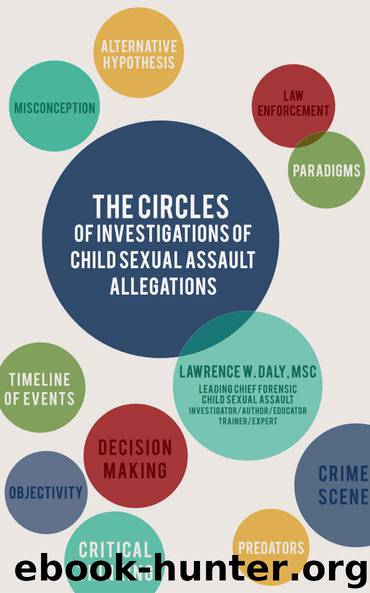The Circles of Investigations For Child Sexual Assault Allegations by Lawrence Daly

Author:Lawrence Daly [Daly, Lawrence]
Language: eng
Format: epub
Publisher: One Daly Corporation
Published: 2016-01-23T23:00:00+00:00
Criminal Cases With Cognitive Bias Meets Fact-Finding
Make no mistake that the SAU Investigator, who spends countless hours on investigating a sexual assault crime and murder, is set out to find the perpetrator and quickly solve the case and move on to the next.
Central Park Jogger Scenario
"But that very motivation can also lead investigators to become overly committed to a theory of the case. Consider, for instance, the Central Park jogger case. In 1989, five teenagers confessed to raping and severely beating a woman as she jogged through Central Park. They quickly retracted their statements, alleging law enforcement had coerced their confessions. No physical or eyewitness evidence linked the suspects to the attack; in fact, semen recovered from the victim appeared to come from only one person whose DNA did not match any of the five suspects. Nevertheless, a jury convicted all five of them. In 2002, another man convicted of committing several other rapes in the area around the same time confessed to the crime. His DNA matched the semen recovered from the victim, and a judge ultimately overturned the original defendants’ convictions (Schanberg, 2002)" (O'Brien, 2007, pp. 1-2). Keep in mind that the prosecution and SAU Investigators on the case don't want to admit that they were wrong, that they had put away five innocent teenagers when all along it was another man who had been roaming around on the streets to commit more rapes in the area. Simply put the physical evidence was not there in the first place. The investigators working on the case badgered the teenagers into confessing. The DNA sample found didn't link the teenagers to the crime. Yet, SAU investigators and the jurors found them to be guilty. Even when the perpetrator was found and the DNA matched, the criminal justice professionals on the case still believed the five teenagers were guilty. But, facts are facts, and it was evident that these teenagers did not commit the crime. The facts of the case are being destabilized, and SAU Investigators contain evidence to fit their theory.
"At some point in every case that goes to trial, investigators must form a theory about what happened and who was involved. The investigation changes from figuring out what happened to proving it. Once someone is charged with the offense, law enforcement and prosecutors have to, to some degree be committed to their theory, even if the investigation continues. Their commitment affects not only their interpretation of the evidence they already have, but also the course of the rest of the investigation. Because the defense rarely has resources to pursue a comparable investigation, any biases in the investigators’ interpretation of the case can profoundly undermine the truth-finding process. Thus, understanding the factors that contribute to investigator bias offers insight into how the investigatory process might be improved so that fewer innocent defendants go to trial in the first place" (O'Brien, 2007, p. 3).
Case Example
A current case that I've been working on involves allegations of child physical assault of a teenage step-son and two young step-daughters.
Download
This site does not store any files on its server. We only index and link to content provided by other sites. Please contact the content providers to delete copyright contents if any and email us, we'll remove relevant links or contents immediately.
Unwinding Anxiety by Judson Brewer(70227)
The Art of Coaching by Elena Aguilar(50087)
The Fast Metabolism Diet Cookbook by Haylie Pomroy(20494)
Rewire Your Anxious Brain by Catherine M. Pittman(17598)
Healthy Aging For Dummies by Brent Agin & Sharon Perkins RN(16614)
Talking to Strangers by Malcolm Gladwell(11902)
The Art of Thinking Clearly by Rolf Dobelli(8859)
Crazy Rich Asians by Kevin Kwan(8367)
Mindhunter: Inside the FBI's Elite Serial Crime Unit by John E. Douglas & Mark Olshaker(7847)
The Compound Effect by Darren Hardy(7573)
Crystal Healing for Women by Mariah K. Lyons(7379)
Therapeutic Modalities for Musculoskeletal Injuries, 4E by Craig R. Denegar & Ethan Saliba & Susan Saliba(7353)
Periodization Training for Sports by Tudor Bompa(7339)
Bodyweight Strength Training by Jay Cardiello(7189)
Becoming Supernatural by Dr. Joe Dispenza(7114)
Wonder by R. J. Palacio(7076)
Tools of Titans by Timothy Ferriss(6960)
Should I Stay or Should I Go? by Ramani Durvasula(6796)
How to Be a Bawse: A Guide to Conquering Life by Lilly Singh(6699)
